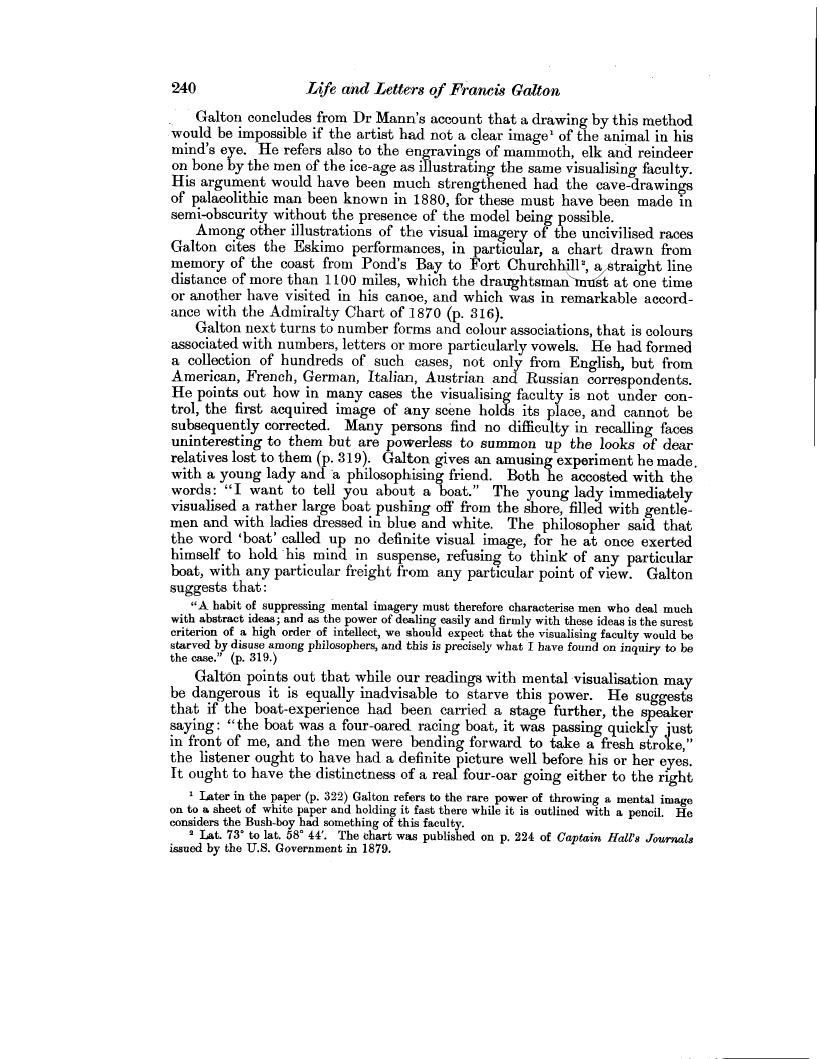240 Life and Letters of Francis Galton
Galton concludes from Dr Mann's account that a drawing by this method would be impossible if the artist had not a clear image' of the animal in his mind's eye. He refers also to the engravings of mammoth, elk and reindeer on bone by the men of the ice-age as illustrating the same visualising faculty. His argument would have been much strengthened had the cave-drawings of palaeolithic man been known in 1880, for these must have been made in semi-obscurity without the presence of the model being possible.
Among other illustrations of the visual imagery of the uncivilised races Galton cites the Eskimo performances, in particular, a chart drawn from memory of the coast from Pond's Bay to Fort Churchhi~ll2, astraight line distance of more than 1100 miles, which the draughtsman dst at one time or another have visited in his canoe, and which was in remarkable accordance with the Admiralty Chart of 1870 (p. 316).
Galton next turns to number forms and colour associations, that is colours associated with numbers, letters or more particularly vowels. He had formed a collection of hundreds of such cases, not only from English, but from American, French, German, Italian, Austrian and Russian correspondents. He points out how in many cases the visualising faculty is not under control, the first acquired image of any scene holds its place, and cannot be subsequently corrected. Many persons find no difficulty in recalling faces uninteresting to them but are powerless to summon up the looks of dear relatives lost to them (p. 319). Galton gives an amusing experiment he made. with a young lady and 'a philosophising friend. Both he accosted with the words: "I want to tell you about a boat." The young lady immediately visualised a rather large boat pushing off from the shore, filled with gentlemen and with ladies dressed in blue and white. The philosopher said that the word `boat' called up no definite visual image, for he at once exerted himself to hold 'his mind in suspense, refusing to think of any particular boat, with any particular freight from any particular point of view. Galton suggests that
"A habit of suppressing mental imagery must therefore characterise men who deal much with abstract ideas; and as the power of dealing easily and firmly with these ideas is the surest criterion of a high order of intellect, we should expect that the visualising faculty would be starved by disuse among philosophers, and this is precisely what I have found on inquiry to be
the case." (p. 319.)
Galton points out that while our readings with mental visualisation may be dangerous it is equally inadvisable to starve this power. He suggests that if the boat-experience had been carried a stage further, the speaker saying: "the boat was a four-oared racing boat, it was passing quickly just in front of me, and the men were bending forward to take a fresh stroke," the listener ought to have had a definite picture well before his or her eyes. It ought to have the distinctness of a real four-oar going either to the right
' Later in the paper (p. 322) Galton refers to the rare power of throwing a mental image on to a sheet of white paper and holding it fast there while it is outlined with a pencil. He considers the Bush-boy had something of this faculty.
2 Lat. 73° to lat. 58° 44'. The chart was published on p. 224 of Captain Hall's Journals issued by the U.S. Government in 1879.

